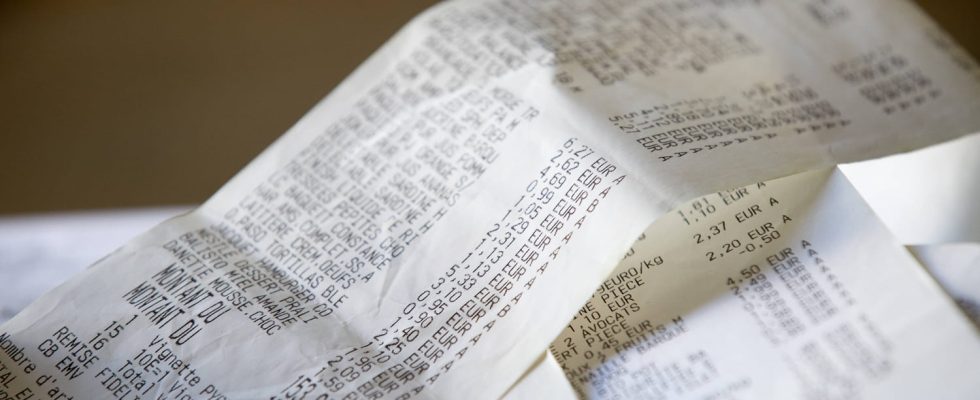From this Tuesday, August 1, the receipt will no longer be distributed automatically by merchants. How will this work?
This little moment of waiting in front of the cashier or the cashier after paying, is (almost) over! From this Tuesday, August 1, merchants will no longer be required to send you the receipt in paper format after a purchase. Present in the “anti-waste” Climate Law, this change is part of the fight against waste and substances dangerous to health. This decision should make it possible to avoid the printing of more than 30 billion tickets per year, an astronomical figure. For the government, the argument is all found: most of the time, the ticket goes to the trash or is lost only a few minutes after its purchase. However, these are difficult to recycle today, both because of the paper used and the ink. “The only thing that will change is that if you want the receipt, you will have to think about asking for it,” explains Minister Delegate for Trade Olivia Grégoire. In detail this concerns:
- receipts produced in sales areas and in establishments open to the public;
- tickets issued by machines;
- bank card receipts;
- vouchers and promotional or reduction tickets
From August 1st, the receipt on demand comes into force.
What is this ? What is changing? For what ? What are the exceptions?
Video explanations. pic.twitter.com/NrfUZacr3U
— Olivia Gregoire (@oliviagregoire) July 25, 2023
What are the exceptions?
Any product purchased and benefiting from a guarantee will always be accompanied by a paper receipt issued automatically by the store. This will be the case, for example, of electronic products or household appliances. You will then not have to apply for it. The reason is simple: the paper receipt is very often the proof of purchase requested to invoke the guarantee and allow the merchant to verify the date of purchase. Here are the other exceptions announced:
- the weighed products. For example, if you buy fruit in a supermarket, whether on a self-service scale or managed by an employee, a receipt will always be printed.
- all services for an amount greater than or equal to 25 euros. This is the case, for example, of a service in a garage, a haircut at the hairdresser, a laundry service, etc.
- restaurant bills or hotel bills.
- automatic and/or underground car parks.
- bank card receipts relating to operations canceled or subject to credit;.
Same thing in the event of payment failure, for example for a payment by card which would not have succeeded (ceiling exceeded, breakdown of the EPT, contactless payment which did not work, etc.)
Will traders be able to offer alternatives?
Yes, it will be possible, for example, to offer a digital receipt, but you will not be obliged to accept it. Many brands have already implemented the electronic receipt, especially if you are registered on their loyalty program. This is particularly the case for franchises and clothing brands. Having an electronic record of the purchase can then be practical in the event of a size error or if you need to make an exchange.
Downside: to enter it, you must most often provide a telephone number, an address and/or an email address and therefore enter the customer file. With the risk of seeing your personal data being stored or entered in other customer files… The digital ticket can be sent by SMS or email, or in the form of a QR Code. But it will be optional. You can always prefer a paper ticket and ask for it at the cash desk. The law only changes the automatic aspect of issuing the paper ticket. It’s up to you to ask for it if you want to get it where it was printed automatically until then.
How to make an exchange?
In the event of a problem with an item, having the receipt is often the guarantee of being able to exchange or be reimbursed for a product. Whether it’s a size error, a defect… The ticket is a precious object for consumers and some people fear its disappearance. As explained above, there are alternatives to continue receiving the receipt. But what to do for clothes, shoes, accessories, food products… You simply have to claim them at the terminal or from a cashier. On the other hand, “if the merchant does not have the technological means to do so, he can refuse it” indicates the government, but do not panic, the store loyalty card, dematerialized for many, will make it possible to find proof of purchase. However, if you leave the store without having taken the slightest step, without a loyalty card or anything… It will now be difficult to offer a return.
Paper receipt or not: the choice is yours
In short, now you will have a choice. It remains to be seen if all traders will really play the game and offer several solutions… In the case of a small trade, the paper ticket should remain widely used. You will then have the choice to ask for it or to do without it. A word of advice: if you have any doubts about the product you have just purchased (in particular the size of a garment), always ask for a ticket in paper or digital format. For smaller purchases, food for example, ask yourself the question of its usefulness. The paper receipt had an advantage in this period of inflation: it allows you to check the prices of everyday consumer products and have a wise eye on your budget in the blink of an eye when leaving your supermarket…
